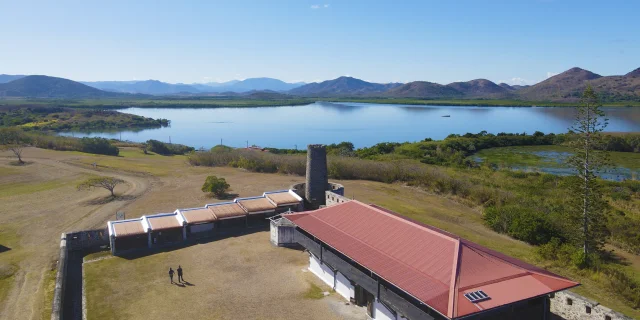Must-see places
An unforgettable dive into New Caledonian colonial history.
Part of the Top 10 must-sees to visit in New Caledonia !
 Fort Teremba Drone1 1
Fort Teremba Drone1 1An unforgettable dive into New Caledonian colonial history.
Part of the Top 10 must-sees to visit in New Caledonia !
It all started in Uaraï Bay when the first stones of the military fort and the Teremba penal colony were laid in 1871. Governor Gaultier de la Richerie wanted to use the building as a penitentiary and administrative centre for a vast territory covering La Foa, Farino, and Moindou.
A genuine village grew up around the prison, complete with a church, school, post office, and civil registry office. Everything was set up to receive free settlers from 1873. Depending on their sentences and behaviour, convicts were now granted plots of land to settle on the sites and not return. Dispossessed of their ancestral lands, the Kanaks revolted. An uprising led by Chief Ataï broke out in 1878. From then on, the fort was transformed into a blockhouse (a fortified military structure) to serve as a possible refuge for settlers and the colonial administration. In 1898, Governor Feillet stopped sending convicts and the site was abandoned in 1908.
The fort, as it can be visited today, owes its restoration to the Marguerite association. In 1984, the association decided to save this historic site from oblivion by applying to South Province to have it classified as a historic monument. Since then, the main buildings have been restored to their original condition, and a considerable effort has been made to bring this painful chapter of New Caledonian history back to life for visitors and residents alike. Classes Patrimoines (Heritage Classes) also welcome local schoolchildren to renovation projects, giving them an insight into daily life at the time. Thanks to the restoration work carried out by the local authorities and the Marguerite association, you can now visit a large part of the buildings as they were in the past.
We recommend that you start your visit outside the fort. Firstly, the site is stunning, with a breathtaking view over the bay. In the dry season, beautiful red flame trees surround the buildings. Secondly, you’ll also get an overall view of the buildings and organisation of the penitentiary, with the blockhouse and administrative centre in the middle. Next to them, the prison. The cells that you can see today convincingly illustrate the conditions in which the convicts were detained. As you stroll through the fort’s grounds, admire the restoration of the watchtower, the powder magazine, and the surrounding wall!
Inside the prison and the main building, you’ll find very interesting exhibitions. On the first floor of the fortress, large panels detail historical events and daily life at the time. Models, mannequins, and interactive kiosks make the tour more entertaining. On the ground floor, you’ll see the work done to preserve the site, thanks to models and a photo exhibition. In the prison, films and animations depict the revolt of 1878 and scenes of life in days gone by.
Explanatory panels have been specially designed for kids. A visit to Fort Teremba is an excellent outing for them too! For groups of 4 or more, you can also book a guided tour !
 Fort Teremba Drone2
Fort Teremba Drone2Several times a year, themed days are organised for visitors to immerse themselves in the penal colony era. The highlight of the year, however, is the Son et Lumières show at Fort Teremba. With no fewer than 150 extras, it depicts the life of the inhabitants of the time and colonisation. The show relies on a well-crafted storyline, costume scenes, and culminates in a magnificent fireworks display. To enjoy the show, you have two options: the stands, which provide a good view of the stage, or an open space where you bring your own mat. Don’t forget to bring a blanket, as it can get chilly after dark. You can also bring your own picnic and enjoy it on site. Otherwise, food and drink stalls are available at the entrance to the site for you to refuel.
Stay over in the vicinity, to avoid a long night drive. To find out when the next show will take place, check our agenda!
The association takes its name from the Marguerite de La Foa footbridge. Arriving in the village of La Foa from Nouméa, you can’t miss this iconic bridge dating back to 1909. Listed as a Historic Monument in 1984 and restored in 1998, take the time to walk across it before or after your visit to Teremba! The Marguerite association works to safeguard the region’s historic heritage. It is also in charge of preparing and organising the Teremba Sound and Light Show.
If you’re coming from Nouméa, take advantage of your visit to Fort Teremba to explore the tourist region of La Foa or Bourail. These two destinations are perfect for combining heritage discovery and outdoor activities. Visit the village of La Foa to admire the Marguerite footbridge. Head to Bourail, with its museum housed in the former prison supply store. Make a detour to Farino and Sarraméa, two authentic towns close to the central mountain range. From there, you can enjoy magnificent hikes and walks on foot, by mountain bike, or even on horseback. If you’re more of a seafarer, head for Poé, an immense white-sand beach. It’s even better to stay in the vicinity of Fort Teremba. The surrounding communities offer a wide range of accommodation options. In our pages, you’ll find the best places to sleep, eat, and move around in the region!
Distance from La Foa: 15 km to the north
By car: turn left after the signpost, continue on a 2½ km track